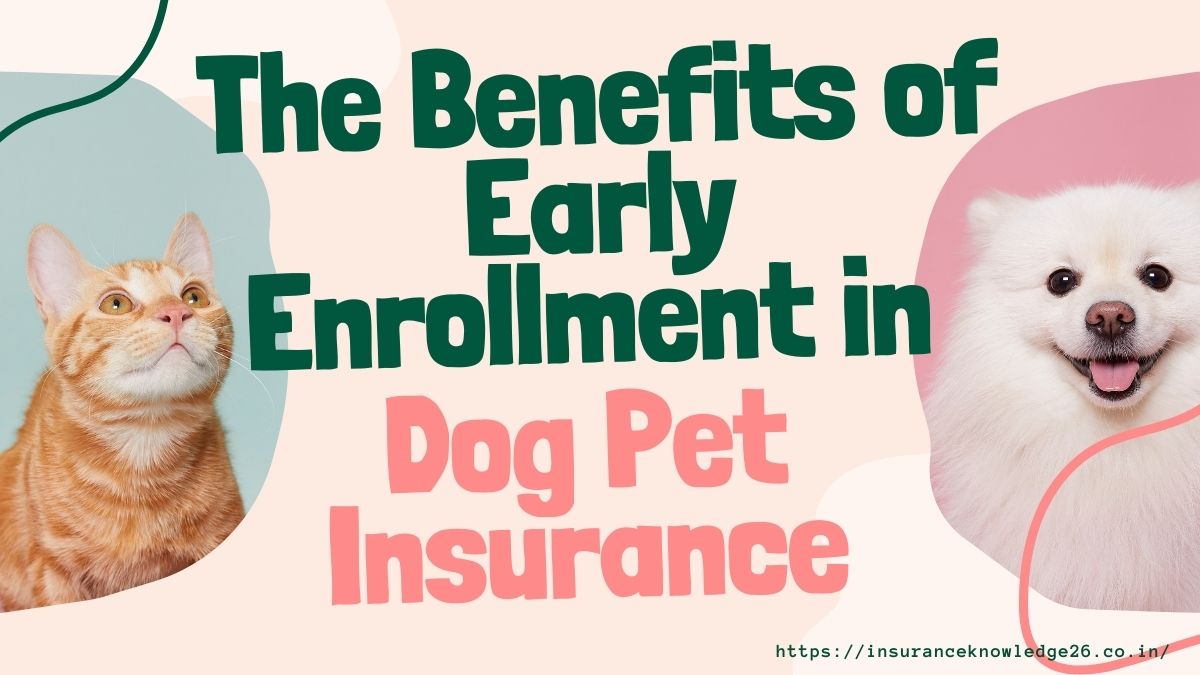In the vast realm of responsibilities that come with pet ownership, ensuring the health and well-being of our canine companions ranks high on the list. Dogs, loyal and loving members of the family, are susceptible to various health issues that can arise unexpectedly. One effective way to mitigate the financial burden associated with veterinary care is through early enrollment in Dog Pet Insurance.
I. Financial Protection Against Veterinary Expenses:
One of the primary advantages of enrolling your dog in pet insurance early is the financial protection it affords against unforeseen veterinary expenses. Just like human healthcare, veterinary care costs have been on the rise, and even routine check-ups and vaccinations can quickly accumulate. Dog Pet Insurance acts as a safety net, covering a significant portion of medical bills, ensuring that your beloved pet receives the best care without causing strain on your wallet. Early enrollment allows you to lock in lower premiums, providing cost-effective coverage throughout your dog’s life.
II. Coverage for Hereditary and Chronic Conditions:
Dogs, like humans, can be predisposed to certain hereditary and chronic conditions. Breeds may carry genetic traits that make them more susceptible to specific health issues, ranging from hip dysplasia to heart conditions. Early enrollment in Dog Pet Insurance ensures coverage for potential hereditary conditions that may manifest as your dog ages. By securing insurance during your dog’s puppyhood, you create a comprehensive shield against the financial implications of chronic illnesses that may require ongoing treatment and care.

III. Timely Access to Preventive Care:
Preventive care plays a pivotal role in maintaining the health and longevity of our furry companions. From regular vaccinations to dental check-ups, preventive measures are essential in keeping dogs healthy and happy. Early enrollment in pet insurance encourages proactive veterinary care by covering the costs associated with routine check-ups and preventive treatments. This, in turn, promotes timely access to preventive care, fostering a healthier and more resilient life for your dog.
IV. Quick Response to Accidents and Emergencies:
Dogs, known for their adventurous spirit, can find themselves in unexpected situations that may lead to accidents or emergencies. Whether it’s a sudden injury during play or an unforeseen illness, the need for immediate veterinary attention is crucial. Early enrollment in Dog Pet Insurance ensures a quick response to such emergencies, allowing you to seek prompt medical care without the added stress of financial considerations. This swift response can make a significant difference in the outcome of your dog’s health, emphasizing the importance of having insurance in place from an early age.
V. Flexibility in Choosing Coverage Options:
Pet insurance providers offer a range of coverage options, allowing pet owners to tailor their plans based on individual needs and preferences. Early enrollment provides the advantage of choosing comprehensive coverage that includes everything from accidents and illnesses to wellness and preventive care. By customizing your dog’s insurance plan early on, you can address specific health concerns, breed-related risks, and anticipated healthcare needs, ensuring a holistic approach to your pet’s well-being.
VI. Lifetime Coverage and Renewability:
Enrolling your dog in pet insurance early often comes with the added benefit of lifetime coverage and renewability. This means that as your dog ages and faces new health challenges, the insurance coverage remains intact. Continuous coverage is particularly valuable in managing chronic conditions that may develop over time, offering financial support for ongoing treatments, medications, and specialized care. The peace of mind derived from knowing that your dog is covered throughout their life is a significant advantage of early enrollment.
VII. Mitigation of Financial Barriers to Quality Healthcare:
One of the unfortunate realities faced by many pet owners is the difficult decision between providing quality healthcare for their dogs and managing the associated financial strain. Early enrollment in Dog Pet Insurance effectively mitigates this dilemma by reducing financial barriers to accessing quality healthcare. By spreading the cost of veterinary care over time through affordable premiums, pet insurance transforms healthcare decisions into choices based on what is best for the well-being of the dog rather than financial constraints.

VIII. Enhanced Focus on Preventive Wellness:
Pet insurance providers increasingly recognize the importance of preventive wellness in maintaining the health of our canine companions. Early enrollment allows you to take advantage of wellness plans offered by insurance providers, which cover routine veterinary visits, vaccinations, and preventive treatments. This emphasis on preventive care not only contributes to the overall well-being of your dog but also fosters a proactive approach to healthcare, identifying potential issues before they become serious concerns.
IX. Ease of Budgeting and Financial Planning:
Early enrollment in Dog Pet Insurance facilitates ease of budgeting and financial planning. With predictable monthly or annual premiums, pet owners can incorporate the cost of insurance into their budget, ensuring that funds are allocated for their dog’s healthcare needs. This financial predictability eliminates the stress associated with unexpected veterinary expenses, allowing pet owners to focus on providing the best possible care for their furry friends without sacrificing their own financial stability.
Conclusion:
In conclusion, the benefits of early enrollment in Dog Pet Insurance are far-reaching, providing a multifaceted approach to safeguarding the health and well-being of our canine companions. From financial protection against veterinary expenses to coverage for hereditary and chronic conditions, the advantages extend beyond mere cost considerations. Early enrollment encourages a proactive approach to canine healthcare, emphasizing preventive wellness and ensuring quick responses to accidents and emergencies.
Choosing to enroll your dog in pet insurance from an early age is an investment in their long-term health and happiness. It is a decision that not only offers financial security but also fosters a sense of responsibility and commitment to providing the best possible life for our loyal and loving companions. As the bond between humans and dogs continues to strengthen, the role of pet insurance in promoting the health, happiness, and longevity of our canine family members becomes increasingly evident.
Summary
| Benefit | Description |
|---|---|
| Financial Protection | Early enrollment provides a safety net against unforeseen veterinary expenses, easing financial strain. |
| Coverage for Hereditary and Chronic Conditions | Insurance covers potential genetic health issues, ensuring ongoing treatment for chronic illnesses. |
| Timely Access to Preventive Care | Encourages proactive veterinary care by covering costs for routine check-ups and preventive treatments. |
| Quick Response to Emergencies | Ensures swift access to immediate veterinary attention in the event of accidents or unexpected illnesses. |
| Flexibility in Coverage Options | Customizable plans allow tailoring coverage to specific needs, addressing breed-related risks and health concerns. |
| Lifetime Coverage and Renewability | Early enrollment often comes with the advantage of lifetime coverage, ensuring continuous protection as the dog ages. |
| Mitigation of Financial Barriers | Reduces financial barriers to quality healthcare, allowing pet owners to prioritize their dog’s well-being. |
| Emphasis on Preventive Wellness | Wellness plans focus on preventive care, promoting overall well-being and proactive healthcare management. |
| Ease of Budgeting and Financial Planning | Predictable premiums facilitate budgeting, eliminating stress associated with unexpected veterinary expenses. |
FAQs
1. What does Dog Pet Insurance typically cover?
Dog Pet Insurance coverage varies among providers, but it generally includes expenses related to accidents, illnesses, surgeries, and medications. Some plans may also cover preventive care, such as vaccinations and routine check-ups. It’s essential to review the policy details to understand the specific coverage offered.
2. At what age should I enroll my dog in pet insurance?
Enrolling your dog in pet insurance early, ideally during puppyhood, is advisable. Early enrollment often comes with lower premiums and ensures coverage for potential hereditary conditions. However, most insurance providers accept dogs of any age, and it’s never too late to secure coverage for your canine companion.
3. Are pre-existing conditions covered under Dog Pet Insurance?
Typically, pre-existing conditions are not covered by pet insurance. These are health issues that your dog had before the insurance policy started. It’s crucial to enroll your dog early to ensure that potential future conditions are covered, as waiting may result in exclusion of certain pre-existing conditions from the coverage.
4. How does reimbursement work with Dog Pet Insurance?
After paying for veterinary services, you can submit a claim to the insurance provider. Reimbursement is usually a percentage of the covered expenses, and the amount depends on your chosen coverage plan. Some providers offer direct payment to the veterinarian, while others reimburse the pet owner after the claim is processed.
5. Can I choose my veterinarian with Dog Pet Insurance?
In most cases, yes. Dog Pet Insurance plans typically allow you to choose any licensed veterinarian. This flexibility ensures that you can continue seeing your current vet or select a new one based on your preferences. It’s essential to check the policy to confirm that your preferred veterinarian is within the network or if there are any restrictions.
Disclaimer
The information provided in this post is based on general knowledge and may not be up-to-date or applicable to specific insurance products or regulations in your jurisdiction. Insurance policies and regulations can vary widely, so it’s essential to research and verify information with local authorities or insurance providers.

